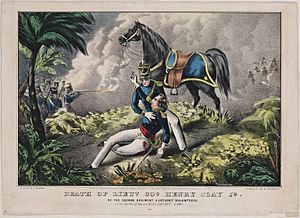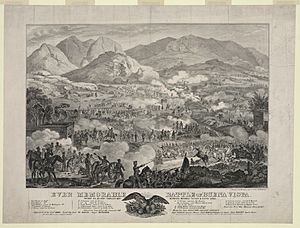Battle of Buena Vista facts for kids
Quick facts for kids Battle of Buena Vista |
|||||||
|---|---|---|---|---|---|---|---|
| Part of Mexican–American War | |||||||
 Battle of Buena Vista by Carl Nebel |
|||||||
|
|||||||
| Belligerents | |||||||
| Commanders and leaders | |||||||
| Zachary Taylor John E. Wool Henry Clay Jr † |
Antonio López de Santa Anna Pedro de Ampudia Manuel Maria Lombardini Antonio Canales Rosillo |
||||||
| Strength | |||||||
| 4,594–4,750 | 15,142 | ||||||
| Casualties and losses | |||||||
| 267 killed 387 wounded 6 missing |
591 killed 1,048 wounded 1,894 missing |
||||||
The Battle of Buena Vista was a major fight during the Mexican–American War. It happened on February 22–23, 1847. In Mexico, it's also known as the Battle of La Angostura. This battle was fought near a village called Buena Vista in Coahuila, Mexico. It was about 12 kilometers (7.5 miles) south of Saltillo. The name La Angostura means "the narrow place," which describes the battlefield.
The battle involved the U.S. forces, mostly volunteers, led by General Zachary Taylor. They faced a much larger Mexican Army, led by General Antonio López de Santa Anna. Both sides claimed victory after the battle. Santa Anna's army left the area with some captured items, but the U.S. forces remained on the field.
Contents
Why the Battle Happened
U.S. President James K. Polk wanted to end the war. He thought invading central Mexico through Veracruz would make Mexico agree to peace. He told General Zachary Taylor to stay in his position at Monterrey. General Winfield Scott was in charge of all U.S. forces in Mexico. He also ordered Taylor to stay put.
However, after the Battle of Monterrey, Taylor moved his army to Saltillo in November 1846. He thought it was important to protect the areas around Monterrey. General John E. Wool also moved his troops to Agua Nueva, south of Saltillo. This was because there were rumors of a Mexican attack.
Santa Anna's Plan
In August 1846, General Antonio López de Santa Anna returned to Mexico from exile. He quickly took command of the Mexican Army. He had tricked President Polk into letting him return, saying he would help make peace. Santa Anna gathered a large force of about 20,000 men. Many of his soldiers were new recruits and poorly equipped. They often lacked uniforms, weapons, and even food.
In January 1847, Santa Anna found a letter from General Scott. This letter showed that some U.S. troops would leave Taylor's army to join forces in Veracruz. Santa Anna decided this was his chance to attack Taylor's smaller force near Saltillo.
Santa Anna's army started their march on January 27 with over 21,000 soldiers. By February 20, they reached Encarnación, south of Saltillo, with about 15,000 men. The Mexican troops faced very harsh winter weather. Many soldiers died from the cold and lack of water. By the time they reached the battle, thousands had been lost to illness, exposure, and desertion.
Choosing the Battlefield
On February 20, U.S. Texas Rangers spotted Santa Anna's army. This made General Taylor pull his troops back to La Angostura. This spot was about 2 kilometers (1.25 miles) south of the Buena Vista ranch.
General Wool was given the job of picking the best place for the battle. He chose a narrow valley that was good for defense. The main road passed through this valley. There were also many ravines (small canyons) to the east and dry riverbeds (called arroyos) to the west. This made it hard for a large army to move easily.
Wool placed Captain John M. Washington's cannons across the road. Other U.S. regiments were placed to support them. The U.S. forces were ready for the fight.
The Battle Begins
Santa Anna chose February 22 for the attack. He didn't know it was George Washington's birthday, which made the U.S. soldiers feel even more patriotic. A captured U.S. soldier said the Mexicans found it hard to believe that General Washington wasn't leading the troops himself.
On February 22, Santa Anna demanded that Taylor surrender. Taylor's aide, William Wallace Smith Bliss, simply replied, "I beg leave to say that I decline acceding to your request."
Santa Anna started his attack with a small fake attack on the American right side. But his main attack was on the American left. General Wool moved more troops to strengthen his left flank. Fighting began in the afternoon, but darkness stopped it.
Day Two of Fighting
General Taylor returned to the battlefield on the morning of February 23. During the night, Mexican forces had moved cannons to try and get around the American left side.
The main assault began with Mexican brigades attacking the U.S. positions. The 2nd Indiana regiment faced a large force of about 7,000 Mexicans. They suffered many casualties and were forced to retreat. This also made the 2nd Illinois regiment fall back slowly.
Mexican cavalry managed to get around the American left side and headed towards the Buena Vista ranch.
Jefferson Davis's Mississippi Rifles were ordered to protect the ranch. They were joined by other volunteers. A large Mexican force attacked the cavalry, and the former governor of Arkansas, Archibald Yell, was killed. The Mexicans reached the ranch, hoping to find supplies. Instead, they found U.S. troops defending it. The Mexican forces then pulled back.
Davis's men, even with Davis wounded, pushed the Mexicans back. A young Mexican officer, José María Montoya, tricked Taylor into a ceasefire. This allowed some trapped Mexican soldiers to escape.
Santa Anna then launched another attack on the main U.S. position. This attack was met by heavy cannon fire. Colonel John J. Hardin of Illinois was killed during this intense fighting.
Captain Braxton Bragg's artillery battery arrived. General Taylor rode over to Bragg and famously told him to "double-shot your guns and give 'em hell, Bragg!" This order, though sometimes misquoted, later became a popular slogan that helped Taylor become president. The Mexican attack was stopped, and the fighting ended as heavy rain began to fall.
On the battlefield, a brave woman named Sarah A. Bowman, known as "The Great Western," helped the wounded American soldiers.
Mexican Withdrawal
Santa Anna believed his army was exhausted and running out of supplies. Many Mexican soldiers were so hungry they risked their lives just to get food from the Americans. Santa Anna decided to withdraw his army back to Agua Nueva. They left their campfires burning to confuse the U.S. troops. Taylor did not chase Santa Anna further south.
Many U.S. soldiers had thought Mexican soldiers were not good fighters. But after battles like Monterrey and Buena Vista, they learned to respect the fighting skills of the Mexican soldier.
Aftermath of the Battle
Santa Anna's army left the battlefield, surprising the U.S. forces. The Mexicans had captured some U.S. cannons and flags, which were displayed in Mexico for many years. Mexican accounts of the battle said their army had won in many parts of the fight, but not a complete victory. Both sides had many dead and wounded.
Many U.S. soldiers who died in the battle were brought home. One of the most famous was Henry Clay Jr., the son of a well-known American politician. His death was shown in many popular prints. His body was later taken back to the U.S. by Jefferson Davis for burial. Other important figures killed were Archibald Yell, a former governor, and John J. Hardin, a political rival of Abraham Lincoln.
Public Reaction in the U.S.
News of the battle took time to reach the U.S. because it was fought in a remote area. At first, there were rumors that the Mexicans had won and captured Taylor. But when the true news arrived in March and April, it caused a huge wave of excitement. People wrote poems, stories, songs, and made art about the battle. Poet Walt Whitman was among those who praised it.
The battle became very popular because most of the American forces were volunteers, not regular army soldiers. People saw them as brave citizen-soldiers who had defeated a much larger professional Mexican army.
Even though General Scott was successfully invading Veracruz at the same time, Taylor's hard-fought victory at Buena Vista became the main news.
Stories and Pictures
Many stories and pictures were made about the battle. Captain James Henry Carleton, who fought there, later wrote about his memories of the combat. Other soldiers also published their accounts. Lieutenant Lew Wallace visited the battlefield a few days later. He wrote about the terrible sights and smells, describing "dead men and horses, bayonets, accoutrements, broken muskets... the earth and rocks were in places black with blood."
Many pictures of the battle were created for the public in the U.S. One of the most famous was based on a sketch by Major Eaton, Taylor's aide. Eaton carefully drew the battlefield and talked to others who fought there. This large picture was praised for being accurate and beautiful. While battle scenes often simplify things, this one was known for showing the landscape well. Many images showed the fierce fighting and highlighted the bravery of the U.S. troops. Carl Nebel also painted a famous scene of the battle as part of a series about the war.
Places Named After the Battle
Several places in the U.S. were named after the Battle of Buena Vista. These include:
- Buena Vista County, Iowa (named in 1859)
- Buena Vista Charter Township, Michigan in Saginaw County, Michigan
- The cities of Buena Vista, Virginia, Buena Vista Colorado, Buena Vista, Oregon, Buena Vista, New Jersey, Buena Vista, Alabama, Buena Vista, Mississippi, and Buena Vista, Georgia.
- Buena Vista Park in San Francisco
Images for kids
-
Map of the country near Buena Vista, Mexico, William Kemble and James Henry Carleton
See also
 In Spanish: Batalla de Buena Vista para niños
In Spanish: Batalla de Buena Vista para niños















